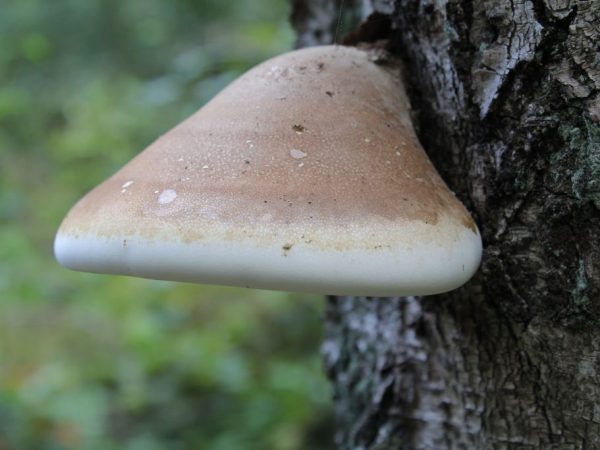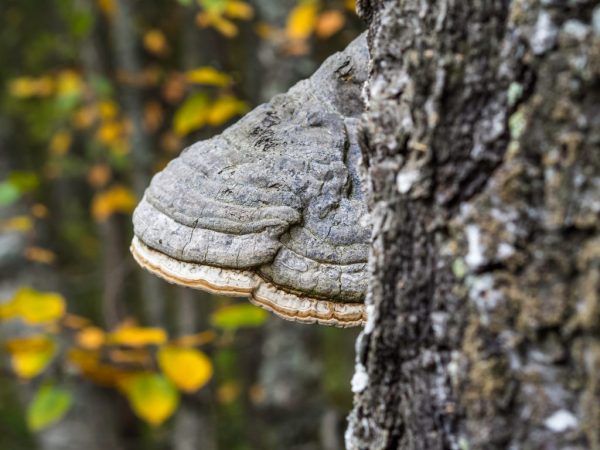The healing properties of birch tinder fungus
The birch tinder fungus parasitizing on a deciduous tree rarely becomes a victim of a mushroom picker itself. Little is known about this species, although its healing capabilities are significant. There is still debate about the edibility of its fruit bodies and ways to remove bitterness.

The healing properties of birch tinder fungus
Description
Birch tinder fungus, according to various sources, is an edible or inedible mushroom - the opinions of experts in this matter differ significantly. Its bitter taste, which is less pronounced in young individuals, speaks in favor of inedibility. They are offered to be eaten.
The species is considered a prime example of a parasitic organism. Tinder fungus on a birch gradually destroys the tree. The mycelium affects only dry or rotten, that is, sick, and therefore weakened specimens, performs a cleansing function in the forest.
Birch is the only tree on which this species parasitizes.
Birch tinder fungus, as the species looks like this:
- there is no leg, characteristic of the caps of pedunculate mushrooms;
- fruiting bodies - annual;
- in young specimens, the fruit body is egg-shaped, in adults it is flat, hoof-shaped, reaches 25 cm in diameter, and up to 5 cm in thickness;
- by the color of the surface, the mushroom is white or cream, covered with a film; turns brown or brown with age, hard;
- hymenophore - tubular;
- the pulp is white, with a strong characteristic mushroom smell and sourish taste.
The species is distributed throughout Russia. Often lives in places with high levels of humidity.
Irina Selyutina (Biologist):
Back in 1967, a book by the Czech scientist V Ripachek, "The Biology of Wood-Destructive Fungi", was published in Moscow, in which he described the species of birch tinder fungus as a parasitic one, settling on weakened trees. According to the data known to date, this species is classified as an active wood destroyer, causing an intensively developing yellowish-brown or reddish-brown rot of a destructive type. As a result, the wood very quickly becomes rotten.
The attitude to the mushroom is ambiguous. Mycologists refer to its inedibility and parasitic nature, and among the people its fruit bodies are used as a means of traditional medicine. The pulp is not dangerous to humans, but unsuitable for food because of the unrecoverable bitterness.
Similar species
The birch tinder fungus has species similar in biology:
- tinder fox;
- tinder fungus;
- tinder fungus false.
The fox tinder fungus has a smaller size and reddish color (externally and internally) in comparison with the birch tinder fungus, which, in addition, also differs in the folded shape of the fruit body. It is thicker, hoof-shaped in shape. Tinder fungus has a reddish-brown fruit body, the flesh inside it is brown. Fruiting bodies of the species tinder fungus are perennial, they are very firmly attached to the surface of the tree trunk. The real tinder fungus, like the false tinder fungus, has a perennial fruiting body, but unlike it, it is characterized by the presence of a leg, with which it is attached to the tree. Its pulp resembles a cork.
Birch tinder fungus is often confused with chaga. Chaga is a separate species of the kingdom of Mushrooms, a sterile form of the tinder fungus. Its fruiting body is outwardly crumpled, resembles a black outgrowth. It also parasitizes birch, the nomenclature name is Inonotus mowed or black birch mushroom.
Beneficial features
The properties of the fruiting bodies of birch tinder fungus are limited only by practical application. Despite the pleasant smell and taste, the bitter aftertaste does not allow them to be eaten. The beneficial vitamins and minerals in pulp have not been studied.
In everyday life, tinder is obtained from the mushroom - a fiber that is highly flammable from a spark. To do this, the mushroom is boiled in an ode with ash, and then dried well.
Contraindications

Be sure to consult with a specialist
Contraindications to the use of the form externally - the presence of allergies, or individual intolerance to the components of preparations based on the fungus. Folk recipes using birch tinder fungus are not recommended for testing on children, the elderly, pregnant women and people with chronic diseases of the skin and joints.
Before using the tinctures inside, a consultation with a specialist is required.
Application
The use of birch tinder fungus in everyday life is wide. Its medicinal properties formed the basis of traditional medicine recipes.
Cooking
Birch tinder fungi have no wide culinary uses. But some mushroom pickers suggest there are young spring specimens. There is less bitterness in them, but it only intensifies with heat treatment. The palatability of the fruit bodies is low, so it makes no sense to cook it.
The medicine
The healing properties of this species were discovered in antiquity. The keratinized skin was removed with whole fruit bodies and disinfected.
The beneficial substances that the pulp contains help with weight loss:
- weaken appetite;
- have a diuretic effect;
- treat constipation and cleanse the intestines.
The general stimulating effect on the body is also noted. In the season of colds, tincture of birch tinder fungus will strengthen the immune system, increase the general mood and emotional background.
Healing tinctures and rubbing from birch tinder fungus are used for joint diseases and wound treatment. The pulp contains natural anti-inflammatory substances. Fruit bodies cut into strips are used as a plaster for small open wounds.
In medicine, the following is obtained from the fruiting body:
- Polysaccharides that serve as the basis of experimental drugs in the treatment of cancer problems.
- An extract (or extract) that has an anti-inflammatory effect and works as a pain reliever.
- Chitin and pectin used to make bowel cleansing products and nutritional supplements.
- Polyporenic acid, isolated from fruiting bodies in the laboratory. It is a part of drugs against ulcers and gastrointestinal inflammation.
- Some biologically active substances that are beneficial for the functioning of the liver and kidneys help to cope with infiltrates.
- Powder from ground pulp. It is a good antiseptic for wounds and promotes healing.
All preparations and tinctures are obtained only from safe tinder fungi on birch. The species tinder fungus is not used for medicinal purposes. Specimens collected in ecologically unfavorable places are not used either.
To prepare the infusion, 1 part of the raw material is infused in warm water, then passed through a meat grinder and again infused in a dark place. At this stage, the ratio of warm water to raw materials is 1: 5.
The powder is used after treating the wound with peroxide or alcohol, sprinkling it under a sterile dressing. On the basis of a powder or a dried fruit body, an alcoholic tincture is prepared for rubbing the joints. 5 g insist on 150 ml of vodka or alcohol for 14 days. The same tincture is diluted with honey and taken orally by 5 ml to strengthen the immune system. The course of treatment lasts 3 weeks.
Conclusion
Birch tinder fungus has long been used as a cosmetic and medical product. Today, alcoholic tinctures and rubbing from its powder are popular. In academic medicine, chemical compounds and extracts are obtained from the pulp that have medicinal properties for the human body.



